Hilarious Heraldic Hijinks
Every year the Eastern College of Heralds issues an April 1 Letter of Intent. Letters of Intent are submitted containing Name and Armory submissions. Most of the College throughout the Known World put up letters in OSCAR (Online System for Commentary And Response), and these items are all from the East’s letter.
Those in the Central Region & further north should particularly appreciate #30.
1: Amma Flammen Wurffer – New Name –
Submitter desires a feminine name.
Consulting herald: Helesone Flaming Sheep
All elements are found in the Family Search Historical Records:
Amma Ehin; Female; Christening; 01 Mar 1607; Biberach (OA. Biberach), Württemberg, Germany; Batch: C00368-5
Agnessa Flammen; Female; Christening; 15 Nov 1559; EVANGELISCH, GROETZINGEN, SCHWARZWALDKREIS, WUERTTEMBERG; Batch: C94434-1
Magdalena Wurffer; Female; Marriage; 29 May 1564; Stuttgart, Württemberg, Germany; Batch: M91614-9
Double surnames are permitted in German per Appendix C.
2: Badde Idea Beare – New Name
Meaning (a warning to others) most important.
Badde is a 16th century English surname which can be used as a given name by precedent [Alton of Grimfells, 4/2010, A-East]. It is found in the Family Search Historical Records:
Anne Badde; Female; Christening; 21 Mar 1551; SOLIHULL, WARWICK, ENGLAND; Batch: P01075-1 (https://familysearch.org/ark:/61903/1:1:JW6F-ZQ9)
Idea is a English given name also found in the Family Search Historical Records:
Idea Brownynge; Gender Unknown; Burial; 19 Dec 1570; Chilham, Kent, England; Batch: B03136-4 (https://familysearch.org/ark:/61903/1:1:JC57-DXQ)
Idea Wilkes; Female; Marriage; 23 Nov 1598; Ombersley, Worcester, England; Batch: M04028-2 (https://familysearch.org/ark:/61903/1:1:NKS4-466)
Double given names are found “late” in English per Appendix A of SENA.
Beare is a surname found in Hitching & Hitching, References to English Surnames in 1601 and 1602 at p. xxii
3: Bathowsse Babe – New Name
Submitter desires a feminine name.
Language (English) most important.
Culture (English) most important.
Consulting herald: Helesone Flaming Sheep
Bathowsse is a 16th cen. English surname which is usable as a given name by precedent. [Alton of Grimfells, 4/2010 LoAR, A-East]:
William Bathowsse; Male; Burial; 06 Apr 1575; St. Botolph Aldgate, London, England; Batch: B00047-6 (https://familysearch.org/ark:/61903/1:1:JC9D-6Q6)
Babe is an English surname:
Madlyn Babe; Female; Christening; 12 Oct 1589; Rye, Sussex, England; Batch: C00086-4
4: Bilbo Biggens – New Name & New Device
 Or, on an open book gules an annulet Or.
Or, on an open book gules an annulet Or.
Submitter desires a masculine name.
Consulting Herald: Yehuda Matzoh Brei Omlet
Bilbo appears as a surname in “Index of Names in the 1582 Subsidey Roll of London” by Aryanhwy merch Catmael (http://www.ellipsis.cx/~liana/names/english/alisurlondon1582.html). Sixteenth century English surnames can be used as given names by precedent. [Alton of Grimfells, 4/2010 LoAR, A-East]
Biggens is a gray-period English surname found in the Family Search Historical Records:
John Biggens, Male, 20 Mar 1630, Coveney, Cambridge, England, B01253-6, https://familysearch.org/ark:/61903/1:1:NG65-2QJ
5: Bilbo Biggens – New Heraldic Will
OSCAR is unable to find the name, either registered or submitted.
The submitter provided the following statement:
My dear Bagginses and Boffins, Tooks and Brandybucks, Grubbs, Chubbs, Hornblowers, Bolgers, Bracegirdles and Proudfoots. Today is my one hundred and eleventh birthday! Alas, eleventy-one years is far too short a time to live among such excellent and admirable hobbits. I don’t know half of you half as well as I should like, and I like less than half of you half as well as you deserve. I, uh, I h-have things to do. I regret to announce — this is The End. I am going now. I bid you all a very fond farewell.
REDACTED, known in the Society as Gandálfr inn hvíti, attested to the following to Frodo Shireborne:
He’s gone to stay with the Elves. He’s left you Bag End along with all his possessions.
We believe this constitutes an acceptable Heraldic Will naming Frodo Shireborne as heir of the submitter. We apologize for the non-standard form.
6: Blue Clews – New Name & New Badge
 Please consider the following possible conflicts identified by OSCAR (many will not be conflicts): Black Willow, House(3/1983), Blackwell, House (4/2002)
Please consider the following possible conflicts identified by OSCAR (many will not be conflicts): Black Willow, House(3/1983), Blackwell, House (4/2002)
(Fieldless) A dog sejant affronty azure
Submitter desires a masculine name.
Sound (bloo cloos) most important.
Consulting heralds: Badde Idea Beare (name) and Conall Blue Dog (badge)
Blue is a 16th century English surname found in the Family Search Historical Records:
Godfridus Blue; Male; Marriage; 03 Feb 1577; Saint Michael, Tatenhill, Stafford, England; Batch: M00984-1 (https://familysearch.org/ark:/61903/1:1:V5KY-292)
By precedent, such surnames can be used as English given names. [Alton of Grimfells, 4/2010 LoAR, A-East].
Clews is found in the gray period in English in the Family Search Historical Records:
Anna Clews; Female; Christening; 01 Oct 1620; SAINT MICHAEL, TATENHILL, STAFFORD, ENGLAND; Batch: P00984-1 (https://familysearch.org/ark:/61903/1:1:V5LC-9BP)
7: Christmas Daye – New Name
Client requests authenticity for 16th cen. English.
Consulting herald: Badde Idea Beare
Christmas is found in Withycombe (3rd edition p.65, header) which states, “this, like other names of Church festivals, was sometimes given to children born on that day and is found from the 13th C down to the present day.” The Oxford English Dictionary (Compact ed. p.408) dates this spelling to 1568.
Daye is an English surname dated to 1569, 1574, 1574, 1584 and 1615 in “Surnames in Durham and Northumberland, 1521-1615” by Julie Kahan (http://www.s-gabriel.org/names/juetta/parish/surnames_d.html).
8: Christmas Daye – New Alternate Name
OSCAR is unable to find the name, either registered or submitted.
Please consider the following possible conflicts identified by OSCAR (many will not be conflicts): Noel Raphael(10/1985)
Noel Revel
Submitter desires a masculine name.
Client requests authenticity for 13th cen. French.
Language (French) most important.
Consulting herald: Badde Idea Beare
Noël is a male given name in “An Index to the Given Names in the 1292 Census of Paris” by Colm Dubh (http://heraldry.sca.org/names/paris.html). The accent is an editorial addition that should be removed for registration. [Gregoire de Lille, 5/2010 LoAR, A-Lochac].
Revel is an unmarked surname dated to 1292 s.n. Revel at p. 171 of “DRAFT: Bynames in Medieval France (Sept. 2014)” by Aryanhwy merch Catmael (http://www.ellipsis.cx/~liana/names/french/frenchbynames.pdf).
9: Costa Rica – New Name & New Device
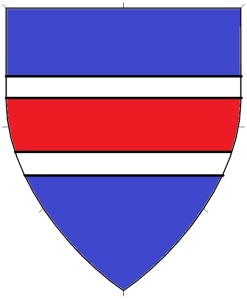 Please consider the following possible conflicts identified by OSCAR (many will not be conflicts): Cassius Drusus(2/2007)
Please consider the following possible conflicts identified by OSCAR (many will not be conflicts): Cassius Drusus(2/2007)
Azure, a fess gules fimbriated argent
Submitter desires a masculine name.
Consulting herald: Julia Chocolate Miaou
Costa is a masculine name dated to 1222 in Fehértói, in this header spelling. Kázmér s.n. Kosztafia (Costa’s son) says it’s a Slavic diminutive of Constantine, and dates the marked patronymic to 1548-1549. Although he includes no unmarked examples of this particular patronymic, such bynames were (and are) very common in Hungarian (as listed in Appendix A).
Rica is dated to 1211 as a masculine name in Fehértói, in this header spelling.
10: Dragon filius Grifonis – New Name
Submitter desires a masculine name.
Meaning (Dragon, son of Grifon) most important.
Consulting herald: Julia Chocolate Miaou
Dragon is a Hungarian given name found in Fehértói s.n. Dragan: +1135/+1262/1566: Lampertus comes in villa Wouita terram … emit … a quodam nomine Dragon (something about Count Lampertus buying land from a guy named Dragon?).
filius Grifonis is a Latin marked patronymic found in Fehértói s.n. Greph: 1289/1302: vinea Eberhardi filii Grifonis ac pueorum eius “vineyard of Eberhard son of Grifon along with his boys” (or something like that).
11: Dragon Reborn – New Name & New Badge
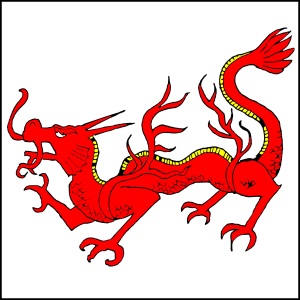 Argent, an oriental dragon passant gules.
Argent, an oriental dragon passant gules.
Submitter desires a masculine name.
No changes.
Consulting herald: Robert Jordan
The submitter provided extremely voluminous documentation, some of which was clearly finished by someone else. Those volumes of paper can be simplified to the following:
Dragon is a 16th century English surname found in the Family Search Historical Records:
John Dragon, Male, Burial, 06 Jun 1597, Salisbury, Wiltshire, England, Batch: B00190-7 ( https://familysearch.org/ark:/61903/1:1:J853-5ZW )
By precedent, late period English surnames can be used as English given names. [Alton of Grimfells, 4/2010 LoAR, A-East]
Reborn is an English surname found in the Family Search Historical Records:
Thomas Reborn, Marriage, 1587, Glatton, Huntingdon, England, Batch: M16864-1 ( https://familysearch.org/ark:/61903/1:1:N6ZP-6BX )
Submitter prefers to depict the dragon with five toes, but his status as emperor is not clear. Submitter likely has the right to display a dragon with four toes, as he was proclaimed king.
12: Dragon Reborn – New Alternate Name
OSCAR is unable to find the name, either registered or submitted.
Randal Thor
Submitter desires a masculine name.
The submitter’s primary name appears elsewhere on this letter.
Randal is an Anglicized Irish male name found s.n. Ranell, dated to 1602, in “Names Found in Anglicized Irish Documents” by Mari ingen Briain meic Donnchada (http://medievalscotland.org/kmo/AnglicizedIrish/Masculine.shtml).
Thor is a 16th century English surname found in the Family Search Historical Records:
Nathaniel Thor; Male; Burial; 25 Feb 1589; Carlton-Castle, Lincoln, England; Batch: B02618-3 (https://familysearch.org/ark:/61903/1:1:JCMV-VYF)
13: Frodo Shireborne – New Name & New Device
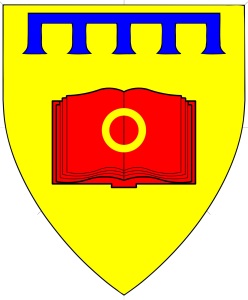 Or, on an open book gules an annulet Or, a label azure.
Or, on an open book gules an annulet Or, a label azure.
Submitter desires a masculine name.
Meaning (from the Shire) most important.
Consulting herald: Gandálfr inn hvíti
Frodo is an Old English male name dated to 1087 in the PASE database (http://www.pase.ac.uk/pdb?dosp=VIEW_RECORDS&st=PERSON_NAME&value=19591&level=1&lbl=Frodo)
Shireborne is a surname found in “Welsh names from Newport charters, 1385” by Constanza of Thamesreach (http://www.s-gabriel.org/names/constanza/newport-1385.html).
As Old English and English/Welsh are part of the same Language Group under Appendix C of SENA, there may be as much as 500 years between name elements. SENA PN.2.C.2.a.
The submitter was named as heir in a heraldic will found elsewhere on this letter. Therefore, the submitter is permitted to register a device conflicting with that of Bilbo Biggens differenced by a label.
14: Furius Heracles – New Name
Submitter desires a masculine name.
Consulting herald: Euripides of Athens
Furius is a nomen found in “A Simple Guide to Imperial Roman Names” by Ursula Georges (http://heraldry.sca.org/names/roman.html)
Heracles is a cognomen found at p. 199 A Study of the Cognomina of Soldiers in the Roman Legions by Lindley Richard Dean (http://books.google.com/books?id=MF0KAAAAIAAJ).
15: Gandálfr inn hvíti – New Name Change
OSCAR NOTE: ‘Old Item’ should contain the former primary name. The form that is there is not a registered name.
Old Item: Gandálfr inn grái, to be released.
Submitter desires a masculine name.
Meaning (the white) most important.
Gandálfr is an Old Norse given name found in Geirr Bassi’s The Old Norse Name at p.10. By precedent, the name is registerable despite its literary association. [Da’ud ibn Auda 4/1991]
inn hvíti is an Old Norse byname meaning “white,” found in “Viking Bynames found in the Landnámabók” by Aryanhwy merch Catmael (http://www.ellipsis.cx/~liana/names/norse/vikbynames.html).
The submitter supplied a lengthy persona story justifying the change, none of which is necessary for documentation. Damn entertaining, though.
16: Geva Dam – New Name
Please consider the following possible conflicts identified by OSCAR (many will not be conflicts): Guy of Aydon(1/2013)
Submitter desires a feminine name.
Meaning most important.
Consulting herald: Temperance Drinkwater
Geva is a feminine given name found in Talan Gwynek’s “Feminine Given Names in A Dictionary of English Surnames” s.n. Geva, dated to 1086, 1199 and 1313.
Dam is a surname dated to 1327 in R&W s.n. Dams.
17: Hodor Hodor – New Name
Consulting herald: Bran Stark
All elements are found in Zofia Abramowicz, Lila Citko, Leonarda Dacewicz. Słownik Historycznych Nazw Osobowych Białostocczyzny (XV-XVII w.) [Historical Dictionary of Personal Names in Białystok (15-17th centuries)], Vol. I. Białystok: Instytut Filologii Wschodniosłowianskiej Uniwersytetu w Białymstoku, 1997.
Hodor is a variant spelling of the attested Polish given name Chodor, dated to 1528 and 1545 (s.n. Chodor). The notes on this name state that it is an East Slavic form of the Old Church Slavonic Fieodor.
Examples of the interchangeability of H- and Ch- include the following names (in Polish-language examples):
- s.n. Chmiel – Hmiel (1560) / Chmiel (1566)
- s.nn. Chocin, Choc, Chocień – Hocin (1560) and Chocień (1560) are both derived from the given name Choc(z)
- s.n. Choc(z)ewocz – Choczewicz / Hocewicz (1560)
- s.n. Chodoszewic – Chodoszewic (1558, 1566) / Hodoszowic (1558
- s.n. Chodziechowni – Hodziechowni (1551) is a compound name derived from the prototheme Chodz(i)-
- s.n. Chw(i)edor – Chwiedor (1558, 1580) / Hwiedor (1640-1)
Polish names use patterns of unmarked patronyms (see Appendix A of SENA).
18: Hodor Hodor Hodor – New Name
Consulting herald: Bran Stark
All elements are found in Zofia Abramowicz, Lila Citko, Leonarda Dacewicz. Słownik Historycznych Nazw Osobowych Białostocczyzny (XV-XVII w.) [Historical Dictionary of Personal Names in Białystok (15-17th centuries)], Vol. I. Białystok: Instytut Filologii Wschodniosłowianskiej Uniwersytetu w Białymstoku, 1997.
Hodor is a variant spelling of the attested Polish given name Chodor, dated to 1528 and 1545 (s.n. Chodor). The notes on this name state that it is an East Slavic form of the Old Church Slavonic Fieodor.
Examples of the interchangeability of H- and Ch- in Polish include the following names:
- s.n. Chmiel – Hmiel (1560) / Chmiel (1566)
- s.nn. Chocin, Choc, Chocień – Hocin (1560) and Chocień (1560) are both derived from the given name Choc(z)
- s.n. Choc(z)ewocz – Choczewicz / Hocewicz (1560)
- s.n. Chodoszewic – Chodoszewic (1558, 1566) / Hodoszowic (1558
- s.n. Chodziechowni – Hodziechowni (1551) is a compound name derived from the prototheme Chodz(i)-
- s.n. Chw(i)edor – Chwiedor (1558, 1580) / Hwiedor (1640-1)
Polish names use patterns of unmarked patronyms (see Appendix A of SENA).
This name can be interpreted as having either a double given name or double surname. The name has the appearance of relationship conflict with Hodor Hodor, who appears elsewhere on this letter. Hodor Hodor has granted permission to conflict as long as there is at least one additional element in this name. The addition of another given name and a byname meets this requirement. This name has a relationship conflict with Hodor Hodor Hodor, but this name should be registerable because the submitter is assumed to allow permission to conflict with himself.
The consulting herald supplied the following: “I asked what name he wanted, and he just said, ‘Hodor’. I explained that we require a byname as well, and he offered one: ‘HODOR’. When I told him there was a conflict, he sounded sad, and said, ‘hodor’. I took it to mean that he allowed me to add this element.”
19: Hodor Hodor Hodor – New Alternate Name
OSCAR is unable to find the name, either registered or submitted.
Hodor Hodor Hodor Hodor
Consulting herald: Bran Stark
All elements are found in Zofia Abramowicz, Lila Citko, Leonarda Dacewicz. Słownik Historycznych Nazw Osobowych Białostocczyzny (XV-XVII w.) [Historical Dictionary of Personal Names in Białystok (15-17th centuries)], Vol. I. Białystok: Instytut Filologii Wschodniosłowianskiej Uniwersytetu w Białymstoku, 1997.
Hodor is a variant spelling of the attested Polish given name Chodor, dated to 1528 and 1545 (s.n. Chodor). The notes on this name note that it is an East Slavic form of the Old Church Slavonic Fieodor.
Examples of the interchangeability of H- and Ch- in Polish include the following names:
- s.n. Chmiel – Hmiel (1560) / Chmiel (1566)
- s.nn. Chocin, Choc, Chocień – Hocin (1560) and Chocień (1560) are both derived from the given name Choc(z)
- s.n. Choc(z)ewocz – Choczewicz / Hocewicz (1560)
- s.n. Chodoszewic – Chodoszewic (1558, 1566) / Hodoszowic (1558
- s.n. Chodziechowni – Hodziechowni (1551) is a compound name derived from the prototheme Chodz(i)-
- s.n. Chw(i)edor – Chwiedor (1558, 1580) / Hwiedor (1640-1)
Polish names use patterns of unmarked patronyms (see Appendix A of SENA) and double given names (Lillia de Vaux, “A Preliminary Survey of Names from the Historical Dictionary of Personal Names in Białystok, 2011 KWHSS Proceedings).
This name can be interpreted as having a double given name and double surname. The name has the appearance of relationship conflict with Hodor Hodor, who appears elsewhere on this letter. Hodor Hodor has granted permission to conflict as long as there is at least one additional element in this name. The addition of another given name and a byname meets this requirement. There is also a relationship conflict with Hodor Hodor Hodor, but the submitter is assumed to grant permission to conflict with himself.
20: Huge Suck Upp – New Name
Submitter desires a masculine name.
Consulting herald: Ryan Hale Hydra
Huge is a 16th century English given name found in the Family Search Historical Records:
Huge Shakelton; Female; Marriage; 17 Oct 1557; Saint Martin, Birmingham, Warwick, England; Batch: M01072-1
Suck is an early 17th century English surname found in the Family Search Historical Records:
Abrie Suck; Female; Burial; 06 Sep 1625; St. Dunstan, Stepney, Middlesex, England; Batch: B02853-0
Upp is an early 17th century English surname found in the Family Search Historical Records:
Amy Upp; Female; Christening; 23 Oct 1625; SAINT ANDREW, PLYMOUTH, DEVON, ENGLAND; Batch: P00183-1
Double surnames are found in English per Appendix A of SENA.
21: Hurte de Eye – New Name & New Device
 Per pale barry wavy azure and argent and barry wavy argent and gules, two concentric annulets counterchanged
Per pale barry wavy azure and argent and barry wavy argent and gules, two concentric annulets counterchanged
Submitter desires a masculine name.
Consulting herald: Eynon Strayne
Hurte is a 16th cen. English surname found in the Family Search Historical Records:
John Hurte; Male; Marriage; 03 Sep 1583; Saint Giles Cripplegate, London, London, England; Batch: M02243-1 (https://familysearch.org/ark:/61903/1:1:NJ5H-XYS)
By precedent, such surnames can be used as given names. [Alton of Grimfells, 4/2010 LoAR, A-East].
de Eye appears as a place name in a Latin charter dated 1491 at pp. 525-26 of Report of the Royal Commission on Historical Manuscripts (https://books.google.com/books?id=Tj3YAAAAMAAJ).
22: Im Groot – New Name & New Device
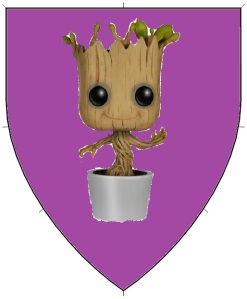 Purpure, a mandrake proper issuant from a mazer argent
Purpure, a mandrake proper issuant from a mazer argent
Consulting herald: Badde Idea Beare
Im is an English female given name found in the Family Search Historical Records:
Im Dytton; Female; Marriage; 24 Nov 1565; Somersby, Lincoln, England; Batch: M03148-2 (https://familysearch.org/ark:/61903/1:1:NV58-G5Y)
Groot is an English surname found in the Family Search Historical Records:
Jennett Groot; Female; Marriage; 26 Oct 1572; Howden, York, England; Batch: M00743-1 (https://familysearch.org/ark:/61903/1:1:N2S9-NZ3)
According to the Pictorial Dictionary of Heraldry:
The mandrake is a plant whose root resembles a human figure; it is normally depicted with vague human features. It may also be called “mandragora”. The mandrake’s narcotic properties made it a favorite with mystics and herbalists.
In armory, the mandrake is rarely found in period armory: e.g., the arms of Bodyam or Bodyham, c.1540 [Dennys 129; cf. also BSB Cod.Icon 291:43]. The mandrake is affronty by default; Society practice grants it difference from a human figure.
23: Kata Kana – New Name
Please consider the following possible conflicts identified by OSCAR (many will not be conflicts): Koga Yoshitsune(6/1991)
Submitter desires a masculine name.
Culture (Hungarian-Japanese?) most important.
Meaning (Hungarian Japanese?) most important.
Consulting herald: Julia Chocolate Miaou
Kata is a Hungarian surname and given name. It is a header in Kázmér, dated in this spelling to 1541, and in the spelling Katha as early as 1402. As a family name, it most often originates as an unmarked matronymic based on a diminutive of Katalin (= Katherine). Kata is also a header in Fehértói, dated as a clan-name from 1220 and later, a feminine name from 1231 and later, and a masculine name from 1243 and later, spelled variously as Katha and Kata in all usages.
Kana is a Hungarian masculine name. It is a header in Fehértói, dated in this spelling to 1214, 1217, 1233, 1251, 1282, 1299, and 1300. Of these, the 1251 citation is part of a vernacular placename (Kanacuta: Kana’s well), showing that this name was the same in Latin and Hungarian. Therefore, the name is appropriate with the surname either first or last.
24: Lenny Briskoo – New Name
Submitter desires a masculine name.
Consulting herald: Jerrigh Orbach
“In the College of Heralds, the submitters are served by two separate but equally important groups, the consulting and commenting heralds who investigate options, and the Submissions Heralds who return the offenders.”
Chung Chung!
Lenny is a gray-period English given name found in the Family Search Historical Records:
Lenny Lazen; Male; 13 Apr 1613; Guston, Kent, England; Batch: B03939-4 (https://familysearch.org/ark:/61903/1:1:JZCJ-NPB)
Briskoo is an italicized 16th/early 17th cen. Anglicized Irish surname found in Woulfe p. 232 s.n. Brioscú.
English and Anglicized Irish are part of the same Language Group under Appendix C of SENA.
25: Mad Margaret – New Name & New Device
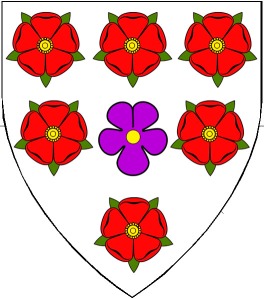 Argent a violet purpure seeded Or within an orle of roses proper
Argent a violet purpure seeded Or within an orle of roses proper
Submitter desires a feminine name.
Consulting herald: Lijsbet Pu’erh Rose
Mad is an English female given name found in the Family Search Historical Records:
Mad Coleng; Female; Christening; 19 Apr 1590; SAINT GILES, READING, BERKSHIRE, ENGLAND; Batch: C01764-2 (https://familysearch.org/ark:/61903/1:1:NPLM-MHX)
Margaret is a late 16th century English given name found in “Late Sixteenth Century English Given Names” by Talan Gwynek (http://heraldry.sca.org/names/eng16/eng16ffreq.html). Unmarked matronymics are found in English per SENA Appendix C.
26: Mad Margaret – New Alternate Name
OSCAR is unable to find the name, either registered or submitted.
Please consider the following possible conflicts identified by OSCAR (many will not be conflicts): Caergwen, House(6/1991), Caírech na hInnsi (2/2012), Caris Maniske (7/1985), Ceara Cháomhanach (3/2007), Ceara Shionnach (6/2012)
Crasey Megge
Submitter desires a feminine name.
Sound (cray-zee meg) most important.
Consulting herald: Lijsbet Pu’erh Rose
Crasey is an English given name found in the Family Search Historical Records:
Crasey Luchington; Female; Burial; 25 Feb 1635; Folkestone, England; Batch: B03582-0 (https://familysearch.org/ark:/61903/1:1:JC1V-N3F)
Megge is an English surname found in R&W s.n. Meggs dated to 1275.
27: Mad Margaret – New Alternate Name
OSCAR is unable to find the name, either registered or submitted.
Poor Peg
Consulting herald: Lijsbet Pu’erh Rose
Poor is a 16th cen. English surname found in the Family Search Historical Records:
Elisabeth Poor; Female; Marriage; 18 Jul 1575; Rye, Sussex, England; Batch: M14836-1 (https://familysearch.org/ark:/61903/1:1:N6KJ-8J9)
Such surnames can be used as given names by precedent. [Alton of Grimfells, 4/2010 LoAR, A-East]
Peg is an English surname found in Bardsley s.n. Pegg dated to 1273.
28: Merlin bat Yoda – New Name
Submitter has no desire as to gender.
Culture (Jewish) most important.
Consulting Herald: Mort d’Arthur
Both name elements are from “A Jewish Memory Book: Nuremburg, 1349” by Eleazar ha-Levi (Lew Wolkoff) in the Proceedings of the 2004 KWHSS.
Merlin – The “Memory Book” has four entries: Meralin eshet (wife of) Yosef, Merlin bot Yoel, Merlin eshet Avraham ha-Levi, and Miralin bot Hotzlin. Beider describes Merlin as a diminutive form of Miriam.
bat – SENA Appendix A lists “bat” (daughter of) as the form for female Hebrew patronymics.
Yoda – The given name Yoda is a variant of Yehudah. The name element appears twice in the “Memory Book:” Yoda bar Yakov and his son Yechiel bar Yoda. Also, Alexander Beider’s A Dictionary of Ashkenazic Given Names gives יודא.[Yod Vov (used as the vowel sound “oh”) Dalet Alef]’ 1392-1793 Frankfurt (28 persons), and Juda 1643-17991 Hamburg (99 persons).
29: Nice Asshe – New Name & New Device
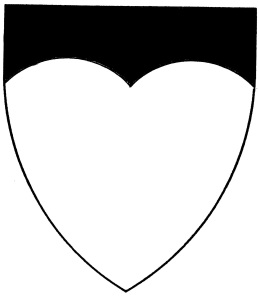 Please consider the following possible conflicts identified by OSCAR (many will not be conflicts): Nakagawa Sukeie(12/2006), Noah Jay (1/2003), Nonesuche House (5/2012)
Please consider the following possible conflicts identified by OSCAR (many will not be conflicts): Nakagawa Sukeie(12/2006), Noah Jay (1/2003), Nonesuche House (5/2012)
Argent, a chief doubly enarched sable
Submitter desires a masculine name.
Client requests authenticity for late period Ireland.
Consulting herald: Any Toole (name) and Istvan Potent Chief (device)
Nice is an Anglicized Irish male name dated to 1602 s.n. Nise in “Names Found in Anglicized Irish Documents” by Mari ingen Briain meic Donnchada (http://medievalscotland.org/kmo/AnglicizedIrish/Masculine.shtml).
Asshe is an italicized 16th/early 17th cen. Anglicized Irish surname found in Woulfe p. 219 s.n. Ághas.
30: Noe More Snow – New Name & New Device
 Please consider the following possible conflicts identified by OSCAR (many will not be conflicts): Ninian Morgan(7/2004)
Please consider the following possible conflicts identified by OSCAR (many will not be conflicts): Ninian Morgan(7/2004)
Argent, on a chief azure three demi-towers issuant from the line of division Or
Submitter desires a masculine name.
Sound (No More Snow) most important.
Meaning (Please, No More Snow) most important.
Consulting Heralds: The entire EK College of Heralds
All elements are found in the Family Search Historical Records:
Noe Frost; Male; Burial; 16 Mar 1593;St. Botolph Aldgate, London, England; Bach: B00047-7 (https://familysearch.org/ark:/61903/1:1:JC98-KQ6)
Jone More; Female; Marriage; 18 Feb 1595; St. Botolph Aldgate, London, England; Batch: M00080-5 (https://familysearch.org/ark:/61903/1:1:NJQ4-336)
Frauncis Snow; Male; Christening; 01 May 1595; SAINT DUNSTAN, STEPNEY, LONDON, ENGLAND; Batch: C05576-5 (https://familysearch.org/ark:/61903/1:1:JMVM-QZJ)
Double surnames are found in English per Appendix A of SENA.
31: Peter Quill – New Alternate Name
OSCAR is unable to find the name, either registered or submitted.
Starr Lord
Submitter desires a masculine name.
Meaning (Star Lord) most important.
Starr is a 16th century English surname found in “Index of Names in the 1582 Subsidy Roll of London” by Aryanhwy merch Catmael (http://www.ellipsis.cx/~liana/names/english/engsurlondon1582n-z.html). By precedent, 16th cen. English surnames can be used as given names. [Alton of Grimfells, 4/2010 LoAR, A-East].
Lord is a surname appearing in Hitching & Hitching, References to English Surnames in 1601 and 1602 at p. xlviii
32: Peter Quill – New Household Name & New Badge
 OSCAR is unable to find the name, either registered or submitted.
OSCAR is unable to find the name, either registered or submitted.
Casa de Gamora
(Fieldless) A maiden vert crined gules and garbed sable
Meaning (Gamora’s house) most important.
Evidence for the pattern Casa de + surname in Spanish is found in the book Istoria de las bienandanzas e fortunas, by Lope Garcia de Salazar, written in the 1470s. Juliana Siren explains:
casa de X where X is a family name: we see both casa de los X and casa de X used interchangeably. This are mostly in the format “house and lineage/lineage and house” (casa e linaje/linaje e casa), so they’re clearly talking about a descent group rather than a physical location. Examples of casa de X from this book include: “casa e linaje de Mendoça,” “la casa de Velasco,” “casa e linaje de Guzman,” etc.
Gamora is a 16th century Spanish surname found in the Family Search Historical Records:
Antonio Gamora; Male; Christening; 12 Feb 1550; Medina del Campo, Valladolid, Spain; Batch: C87257-1 (https://familysearch.org/ark:/61903/1:1:FFMZ-N4B)
Juan Gamora; Male; Christening; 06 Sep 1533; SAN ESTEBAN, PORTILLO, VALLADOLID, SPAIN; Batch: J87320-2 (https://familysearch.org/ark:/61903/1:1:VWXL-R96)
The submitter therefore believes that Casa de Gamora fits the documented pattern. As both the named submitter and the nice green lady with him have very large guns, we are inclined to agree.
33: Rogue Flamenco – New Name
Submitter desires a masculine name.
Language (Spanish) most important.
Culture (Spanish) most important.
Consulting Herald: Ermine Butterscotch Crampet
The entire name is found in Spain in the Family Search Historical Records:
Rogue Flamenco; Male; Christening; 28 Aug 1553; SAN MIGUEL, VALLADOLID, VALLADOLID, SPAIN; Batch: C87115-1 (https://familysearch.org/ark:/61903/1:1:FR73-4HL)
34: Scarlet O Hara – New Name & New Badge
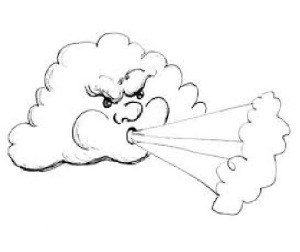 (Fieldless) An aeolus contourny argent
(Fieldless) An aeolus contourny argent
Client requests authenticity for South.
Meaning (‘frankly, doesn’t give a damn’) most important.
Scarlet is an English given name found in the Family Search Historical Records:
Scarlet Stacy; Male; Christening; 11 Jun 1591; SAINT GREGORY BY SAINT PAUL, LONDON, LONDON, ENGLAND; Batch: C05426-1 (https://familysearch.org/ark:/61903/1:1:NYNC-6ML)
O Hara is an Anglicized Irish surname dated to 1602 found s.n. Cormock in “Names Found in Anglicized Irish Documents” by Mari ingen Briain meic Donnchada (http://medievalscotland.org/kmo/AnglicizedIrish/Masculine.shtml)
English and Anglicized Irish can be combined under Appendix C of SENA.
According to the Pictorial Dictionary of Heraldry, s.v. wind (http://mistholme.com/dictionary/wind/):
Winds are masses of air in natural motion. Invisible in nature, they’re depicted in art as a human heads issuant from cloud, usually shown visibly blowing air from their mouths. Frequently depicted in period art (e.g., on maps), we know of a single example in period armory, in the canting arms of de Zeffiro, c.1550 [BSB Cod.Icon 268:233].
In Society blazon, the generic wind may also be called an “aeolus”. Other types of wind include the “boreas”, an icy-bearded old man; the “zephyr”, an androgynous youth; and the female “mistral”. Winds face dexter by default, and should be shown in profile (though some are affronty); they should never be in trian aspect.
35: Silk Pouch – New Name
Consulting herald: Julia Chocolate Miaou
Silk is based on Fehértói s.n. Selk, where the spelling Sylk is dated to 1292 as the name of a landowner. I/y switches are common in these records, to the point that Fehértói treats the letters as equivalent, uniformly using ‘i’ in headers and cross-references.
Pouch is a Hungarian surname dated in this spelling to 1383 s.n. Pócs in Kázmér. It’s an unmarked patronymic based on an old diminutive of Pál (= Paul). It is also found as a secondary header under Poch in Fehértói Katalin: _Árpád-kori személynévtár_ (Akadémiai Kiadó, Budapest, 2004), dated to 1275 and 1300 as a masculine name.
36: Simon Peres – New Name
Please consider the following possible conflicts identified by OSCAR (many will not be conflicts): Schönberg, Haus(1/1995), Simon Briggs (11/2011), Simon Piroska (7/2002), Susannah of York (12/2013)
Submitter desires a masculine name.
Language (Anglo-Hungarian?) most important.
Culture (Anglo-Hungarian?) most important.
Consulting herald: Julia Chocolate Miaou
Simon is an English male given name found in R&W s.n. Simon: Simon 1134-40, William le fiz Simon Hy2, William, John Simon 1291, 1296.
Peres is a surname found in R&W s.n. Pierce: Geoffrey Peres 1237.
Alternatively, Simon is found as a given name in “Hungarian Personal Names of the 16th Century” by Walraven van Nijmege (http://heraldry.sca.org/names/hungarian/index.html#thelist) dated to 1560 and 1574.
Peres is found in Kázmér s.n. Peres: This spelling continuously from 1391. Occupational term meaning “lawyer”.
37: Simon Peres – New Alternate Name
OSCAR is unable to find the name, either registered or submitted.
Peres Simon
Submitter desires a masculine name.
Language (Anglo-Hungarian?) most important.
Culture (Anglo-Hungarian?) most important.
Consulting herald: Julia Chocolate Miaou
Peres is a male given name found in R&W s.n. Pierce: Peres le cordener 1292
Simon is an English surname found in R&W s.n. Simmons: William Simon 1291 and in R&W s.n. Simon: John Simon 1291, 1296.
Alternatively, Peres is a Hungarian occupational byname meaning “lawyer” found in Kázmér s.n. Peres: This spelling is found continuously from 1391.
Simon is a Hungarian male given name found, among other places, in Kázmér s.n. Német: 1557 Nemet Simon.
38: Socrates Thunder – New Name
Submitter desires a masculine name.
Sound (THUN-DER!) most important.
Language (English) most important.
Culture (English) most important.
Consulting Herald: Badde Idea Beare
The entire name is found in the Family Search Historical Records for England:
Socrates Thunder; Male; Marriage; 15 May 1585; High Ercall, Shropshire, England; Batch: M00896-1 (https://familysearch.org/ark:/61903/1:1:N28L-2Z5)
39: Soyland Greene, Barony of – New Order Name
OSCAR is unable to find the name, either registered or submitted.
Award of No-merit
Consulting herald: Badde Idea Beare
This Order name follows the pattern of naming orders after the given names of individuals. The May 2011 LoAR states that “[a] given name can be used to create an order name (one named after a founder or inspiration).” [Order of Taillefer, 5/2011 LoAR, A-Lochac].
No-merit is an English given name dated to 1589 in Bardsley’s Curiosities of Puritan Nomenclature
40: Soyland Greene, Barony of – New Order Name & New Badge
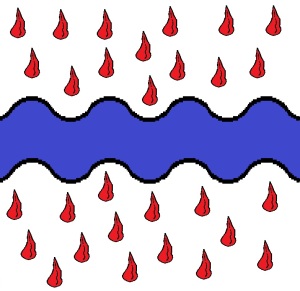 OSCAR is unable to find the name, either registered or submitted.
OSCAR is unable to find the name, either registered or submitted.
Order of Ebola
Argent goutty de sang, a fess wavy azure
Sound (ee-bow-lah) most important.
Consulting herald: Badde Idea Beare
This award is intended for those whose enthusiasm for serving the Barony is infectious.
This Order name follows the pattern of naming orders after the given names of individuals. The May 2011 LoAR states that “[a] given name can be used to create an order name (one named after a founder or inspiration).” [Order of Taillefer, 5/2011 LoAR, A-Lochac].
Ebola is a German female given name found in the Family Search Historical Records:
Ebola Helkings; Female; Marriage; 09 Apr 1622; Borken, Westfalen, Preußen, Germany; Batch: M98571-1 (https://familysearch.org/ark:/61903/1:1:J4XM-WMF)
The Lingua Anglica Order of can be used with the German Ebola per SENA NPN 1.B.2.
41: Soyland Greene, Barony of – New Branch Name & New Device
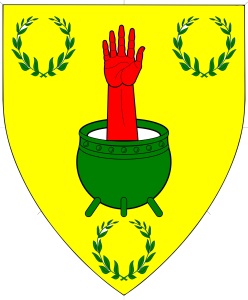 Or, in pale a cubit arm palewise gules emergent from a flesh-pot all between three laurel wreaths vert.
Or, in pale a cubit arm palewise gules emergent from a flesh-pot all between three laurel wreaths vert.
Meaning (is people!) most important.
Consulting heralds: Butterscotch Crampet (name) and Matzoh Brei Omelet (armory)
Barony is one of the designators for local groups per SENA Appendix E.
Soyland – Watts, s.n. Soyland Moor. The entry says it’s derived from the the place name Soyland + ModE moor. Soyland = ‘newly-cultivated swamp land’. Dated instances include Soyland(e) (dated 1542-1649), and Soyland Mo(o)r(e) (dated 1624).
Greene – surname found in Hitching & Hitching, dated 1601-2. Green in various spellings is also part of compound place names, such as in the example Acton Green (dated 1640), Watts, s.n. Acton Green.
The pattern of toponym + surname is found in Juliana de Luna, “Compound Placenames in English” (http://medievalscotland.org/jes/EnglishCompoundPlacenames/). Early Modern English examples of such manorial additions include Broughton Astley (dated from 1535) and Broughton Pouges (dated 1526), Marsh Gibbyon (dated 1553×1601), and Lye Dallamer (dated 1558×1601), found in Watts, s.nn. Broughton, Marsh, and Leigh, respectively.
A petition in support of the name was provided. We’re uncertain why there are bite marks on the paper . . .
42: Soyland Greene, Barony of – New Heraldic Title
OSCAR is unable to find the name, either registered or submitted.
Hunger Pursuivant
SENA NPN 1.B.4 states that the standard heraldic designators for heraldic titles for Kingdoms are Herald and Pursuivant.
“Heraldic Titles from the Middle Ages and Renaissance” by Juliana de Luna (http://medievalscotland.org/jes/HeraldicTitles/) provides evidence of English heraldic titles based on surnames.
Hunger is an English surname found in the Family Search Historical Records:
Jhoone Hunger; Female; Marriage; 3 Jan 1599; St. Marys, Leyton, Essex, England; Batch: M16395-1 (https://familysearch.org/ark:/61903/1:1:NKXV-3H7)
43: Tooth Feri – New Name
Submitter desires a masculine name.
Language (Hungarian) most important.
Culture (Hungarian) most important.
Consulting herald: Julia Chocolate Miaou
Tooth is a Hungarian surname meaning “Slav, Slovak” dated in this spelling to 1542 s.n. Tót in Kázmér Miklós: _Régi Magyar Családnevek Szótára_ (Magyar Nyelvtudományi Társaság, Budapest, 1993).
Feri is a masculine name dated to 1560 in Walraven van Nijmegen: “Hungarian Personal Names of the 16th Century” (heraldry.sca.org/names/hungarian/index.html). Feri is a diminutive of Ferenc (= Francis), which means that it is appropriate in a vernacular context, where the surname comes first.
